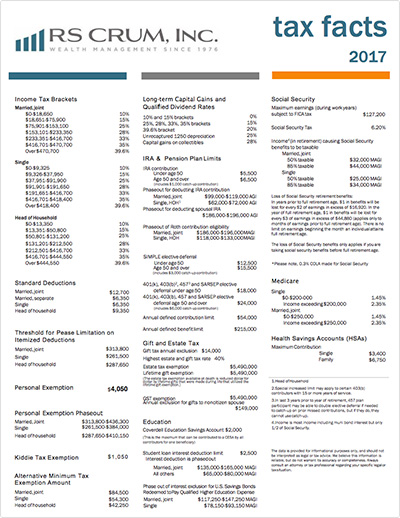By Ashley Bleckner, CFP®, MA
With a new year comes new opportunities, new adventures, and yes, new tax rates. The Internal Revenue Service (IRS) announced the 2017 adjustments and we’ve summed up the highlights of relevant changes to make it less taxing on you (pun intended).
Before we review what’s different in 2017, it’s important to remember tax changes for 2017 are not applicable to the taxes you will file this April for the 2016 tax year.
1. Tax brackets adjust for inflation. Increase is minimal, between 0.5% – 0.8%
2. Medical expense deduction changes for seniors. In 2016, taxpayers 65 and older were able to deduct medical expenses that exceeded 7.5% of their Adjusted Gross Income (AGI) when itemizing deductions. Beginning in 2017, everyone (including those over 65) will adjust to the 10% threshold.
3. Traditional IRA and Roth IRA phase-outs adjust higher. While there is no change in the amount you are able to contribute to a Traditional IRA or Roth IRA ($5,500; $6,500 age 50+), the phase out (maximum income) amount is slightly higher. (Note: 401k contributions also remain the same at $18,000 & $24,000 for those over 50 years old
Married – Traditional IRA ($99,000 – $119,000); Roth IRA ($186,000 – $196,000)
Single – Traditional IRA ($62,000 – $72,000); Roth IRA ($118,000 – $133,000)
4. The estate tax exemption will increase. The estate tax exemption is increasing in 2017. Estates of individual decedents who pass away in 2017 will be exempt up to $5.49 million, up from the 2016 amount of $5.45 million. The annual gift exclusion remains at $14,000 per person.
With President Donald Trump taking over the Oval Office, it is important to be aware of the tax reform he and Congress promise to accomplish while in office. The details are light, but here is what Trump has outlined thus far:
- Federal tax brackets would be simplified down to three (compared to seven today) with tax rates of 12%, 25%, 33% at a combined income of $225,000 ($112,500 for single filers).
- The standard deduction would be combined with the personal exemption at $30,000 for married couples filing jointly ($15,000 for single filers).
- Itemized deductions would be capped at $200,000 for married couples filing jointly ($100,000 for single filers).
- Elimination of the 3.8% Obamacare tax on net investment income for people with incomes greater than $250,000 for married filing jointly ($200,000 for single filers).
- Repeal the alternative minimum tax and the estate tax.
Trump’s proposed tax changes are by no means final; however, Congress has identified tax reform as a top initiative. We will continue to stay ahead of you in regards to tax changes.


